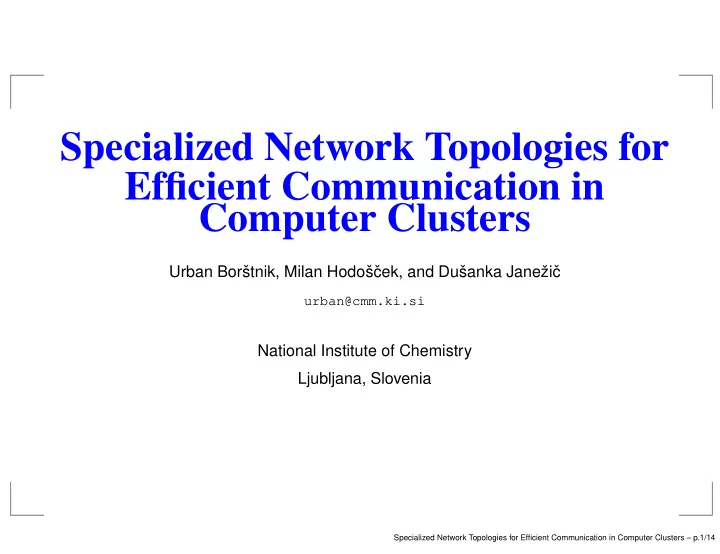

Specialized Network Topologies for Efficient Communication in Computer Clusters Urban Borˇ stnik, Milan Hodoˇ sˇ cek, and Duˇ sanka Janeˇ ziˇ c urban@cmm.ki.si National Institute of Chemistry Ljubljana, Slovenia Specialized Network Topologies for Efficient Communication in Computer Clusters – p.1/14
Why Clusters? Use in computational methods Replace traditional supercomputers. Low cost. (Off-the-shelf) availability. Precursors are networked workstations. Developed in the last couple of years Personal Computers attained supercomputer performance. Cheap & fast networking equipment. Specialized Network Topologies for Efficient Communication in Computer Clusters – p.2/14
Networking Clusters Networking speed and latency problems. Switches widely-used; easy implementation; everyone communicates with everyone. However costly; not expandable. Specialized Network Topologies for Efficient Communication in Computer Clusters – p.3/14
� � � Networking Clusters: Special Topologies Special topologies Point-to-point connections form topology. Various types (mesh, hypercube, full graph, ). Routing: practically needs a switch. Special software to take advantage of topology (software conforms to hardware). Or, we can design a topology to effi ciently perform some types of data transfer. (Hardware conforms to software.) Specialized Network Topologies for Efficient Communication in Computer Clusters – p.4/14
Topologies Logical topology Describes the software communication pattern. Physical topology Describes the physical connection pattern. The physical topology should cover at least the logical topology. Specialized Network Topologies for Efficient Communication in Computer Clusters – p.5/14
CHARMM and CMPI CHARMM for molecular dynamics simulation of macromolecules Primarily uses 2 data-transfer operations. Uses own CMPI library for collective operations. Distributed Vector Global Sum, Distributed Vector Global Broadcast DVG Sum: Vectors added, resulting vector left scattered across nodes. DVG Broadcast: Scattered vector broadcast to all nodes. Specialized Network Topologies for Efficient Communication in Computer Clusters – p.6/14
CMPI Collective Operations Effi cient hypercube implementation Different amount of data is transferred in each dimension. processors p2 p3 p0 p1 p2 p3 m components a0 a1 a2 a3 1st dim. transfer n−tuple b0 b1 b2 b3 (1 n−tuple) step 1 c0 c1 c2 c3 d0 d1 d2 d3 p0 p1 p2 p3 a0+a1 a1 a2+a3 a3 m b0 b0+b1 b2 b2+b3 2nd dim. transfer step 2 c0+c1 c1 c2+c3 c3 (1/2 n−tuple) d0 d0+d1 d2 d2+d3 p0 p1 n/2 n/4 a a1 a2+a3 a3 a=a0+a1+a2+a3 Final state b0 b b2 b2+b3 b=b0+b1+b2+b3 n c0+c1 c1 c c3 c=c0+c1+c2+c3 d d0 d0+d1 d2 d=d0+d1+d2+d3 Specialized Network Topologies for Efficient Communication in Computer Clusters – p.7/14
� Hierarchical Hypercube A Hierarchical Hypercube topology is a hypercube with links of different speeds for different dimensions. DVG Sum & Broadcast transfer 1 2 data in each successive dimension. Hierarchical hypercube has the fastest links for the 1st dimension, and progressively slower for the other dimensions. Ideally no link saturated, no link with spare capacity. Specialized Network Topologies for Efficient Communication in Computer Clusters – p.8/14
CROW5 Uses hierarchical hypercube topology to connect 16 SMP PCs Dual Athlon MP-1600+ Gigabit ethernet cards Fast ethernet switch 1st dimension: system bus. 2nd dimension: point-to-point gigabit Ethernet. 3rd–5th dimensions: fast Ethernet switch. (Alternate view: increasing performance of switched PCs with point-to-point links.) Specialized Network Topologies for Efficient Communication in Computer Clusters – p.9/14
CROW5 topology 100 Mb/s Switch 1st dim.: Bus (>2660 Mb/s) 2nd dim.: Gigabit Ethernet (1000 Mb/s) 3rd, 4th, 5th dims.: Fast Ethernet (100 Mb/s) Specialized Network Topologies for Efficient Communication in Computer Clusters – p.10/14
Comparison to Other Network Types Benchmark: 100 step dynamics simulation of protein HIV Integrase, 1 fs step size. Table of speedups (as compared to 1 processor): Topology Number of Processors 2 4 8 16 32 Hier. Hypercube 1.8 3.0 4.4 7.1 9.2 1 Gb/s switch 1.8 3.1 4.6 8.0 10.7 100 Mb/s switch 1.8 2.9 4.0 5.4 6.3 Comparable to a gigabit switch. Faster than just an ethernet switch. Specialized Network Topologies for Efficient Communication in Computer Clusters – p.11/14
Redundancy Features Computers connected with both point-to-point links and hub/switch. Redundant links if one fails. Possible redundancy between any computers in the cluster. Specialized Network Topologies for Efficient Communication in Computer Clusters – p.12/14
Conclusions Clusters are very suitable for numerically intensive calculations. An appropriate topology can provide a noticeable performance improvement. We developed a hierarchical hypercube topology based on communication patterns in software to speed up computation. The hierarchical hypercube offers a performance improvement over standard switching technology for only a small additional cost. Specialized Network Topologies for Efficient Communication in Computer Clusters – p.13/14
Acknowledgement Ministry of Education, Science, and Sport of Slovenia Specialized Network Topologies for Efficient Communication in Computer Clusters – p.14/14
Recommend
More recommend